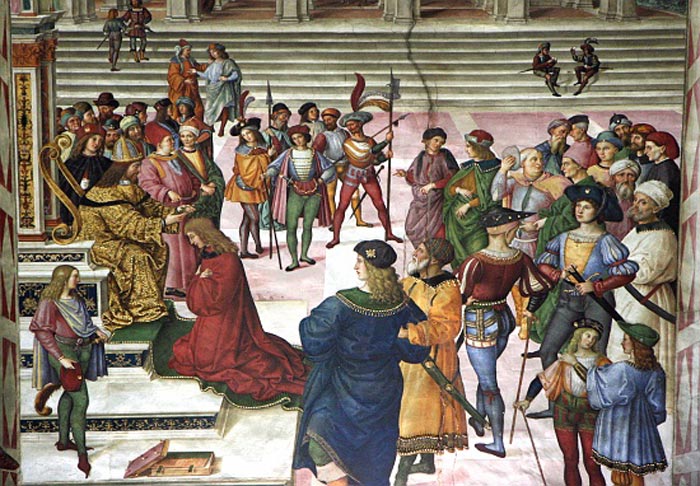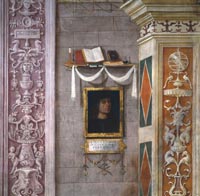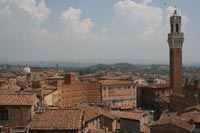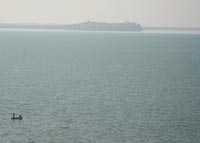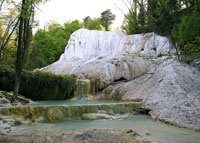| |
|
| |
|
|
|
|
|
|
| |
 |
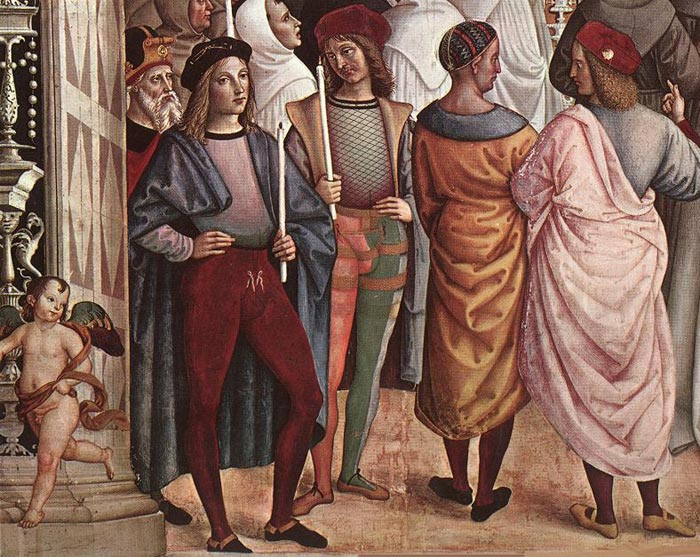 |
Pope Aeneas Piccolomini Canonizes Catherine of Siena (detail), with on the left presumed portraits of Rafael and Pinturicchio
Piccolomini Library, Duomo, Siena |
|
 |
 |
| |
|
|
|
| |
|
Pinturicchio (Bernardino di Betto)
|
Bernardino di Betto, known also as Pintoricchio, was born between 1456 and 1460 in Perugia to a modest family of artisans. The early life of the painter seems to have been very unhappy and was further complicated in 1475 when his father, a simple cloth tanner, died of the plague.
Some years before, however, Giapeco Caporali, the extraordinary miniaturist, opened a bottega on the same street as the young Bernardino’s family home and it is assumed that the young boy had his first experiences with brushes and colours in the Caporali bottega. These were years of a great artistic fervour in Perugia; the city was becoming an eminent centre for artistic activities in central Italy. In the early years, Pintoricchio participated in this artistic revival, sometimes as a spectator, other times as a protagonist; he is recognised to have worked on the majestic tables that recount the stories of San Bernardino in 1473, while also working alongside Perugino on the scaffolding of the Sistina.
It was not, however, until 1481 that his first authored works are documented, following his enrolment in the guild of Artists and Painters in Porta Sant’Angelo, Perugia. Working in Rome allowed him to meet new and influential figures: between 1482 and 1485 he painted the cappella Bufalini all’Aracoeli, he intermittently returned to his home town to complete some of his works and to carry out small commissions, some of which were obtained thanks to his nephew, Girolamo di Simone - the extremely young Canon of the Cathedral of San Lorenzo of Perugia. This fact may also explain the excellent relationship that Pintoricchio had with Innocenzo VIII, for whom, between 1487 and 1488, he worked on the site of his apartments in the Vatican: unfortunately only part of these are still in existence as the rest was destroyed in order to make space for the Pio Clementino Museum.
In 1490 Bernardino was at work in the Sala dei Mesi in the Palace of Cardinal Domenico Delle Rovere and in the Chapel Santa Maria del Popolo.
Two years later he came to Orvieto for a commission in the Duomo that was completed only in 1496. In the meantime Alessandro VI Borgia had become Pope and commissioned the Umbrian artist to decorate his apartments in the Vatican, a grandiose project that kept Pintoricchio busy in Rome until 1495.
By the 2nd January of the same year, the altarpiece of Santa Maria dei Fossi, perhaps one of his most significant works, was still awaiting completion. The works in Spoleto, Perugia and Orvieto brought money and in 1501 also recognition from the political powers that appointed him to hold the position of prior of the Arts in Perugia.
The events in the life of Pintoricchio are closely linked to the political landscape of Perugia, he was a familiar and loyal servant to Cesare Borgia and he was also connected to the Baglioni family, from whom he received the commission to decorate the walls of the Capella Bella in the Church of Santa Maria Maggiore in Spello, where - between the autumn of 1500 and the spring of 1501 - he created paintings of such magnificent beauty and skill that his fame and eminence in artistic circles in Umbria was ensured for many years to come.
Many consider his crowning achievement to be the stunning cycle of frescoes that illustrated the life of Enea Silvio Piccolomini, Pope Pio II, located in the Piccolomini library in Siena. Ambroggio Barocci designed the grandiose architectural structure and the draughts for the illustrated scenes were prepared by a young Raffaello; these details only serve to underline the greatness achieved by the Perugian painter.
In 1506 the frescoes were completed and Pintoricchio received the commission to paint the pala di Sant’Andrea in Spello, which he eventually left to Eusebio da San Giorgio to complete.
Between 1509 and 1510 he painted his last Roman work, the vaulted ceilings on the Capella Delle Rovere in Santa Maria del Popolo.
In 1513 he retired, due to ill health, to the Sienan countryside, where he died on the 11th December. He was rich but alone, following abandonment by his wife. It was a sad and lonely end for an artist that was initially considered, “deaf, small and unprepossessing,” yet nonetheless, had managed to attain greatness.
Bernardino di Betto (Benedetto), Italian painter called II Pinturicchio, was, like Perugino, a native of the district around Perugia.
He was thought by his contemporaries to have been a pupil of Perugino and to have had a share in Perugino's frescoes in the Sistine Chapel in the early 1480s. According to Vasari, Pinturrichio was a paid assistant of Perugino.
The works of the Perugian Renaissance school are very similar; and paintings by Perugino, Pinturicchio, Lo Spagna and Raphael may often be mistaken one for the other. In the execution of large frescoes, pupils and assistants had a large share in the work, either in enlarging the master's sketch to the full-sized cartoon, in transferring the cartoon to the wall, or in painting backgrounds or accessories.
|
|
|
|
| |
|
Siena
|
In Siena - where he finally settled, married, had children, and died - he had important commissions for the Cathedral, for the Church of San Francesco, and for Pandolfo Petrucci, the chief citizen of the city.
|
|
Aeneas Piccolomini is crowned poet laureate by Holy Roman Emperor Frederick III in 1442.
Fresco by Pinturicchio, Piccolomini Library, Duomo, Siena
|
Frescoes in the Piccolomini Library of the Duomo in Siena
|
|
|
About halfway down the nave on the left is the entrance to the Piccolomini library, famed for its precious illuminated choir books and beautifully preserved Renaissance frescoes painted by Pinturicchio, probably based on designs by Raphael.
The library was commissioned by Cardinal Francesco Piccolomini, Archbishop of Siena (later Pope Pius III), to honor the memory and book collection of his maternal uncle Enea (Aeneas) Piccolomini, who became Pope Pius II.
Pinturicchio painted this cycle of frescoes around the library between 1502 and 1507, representing Rafael and himself in several of them. This masterpiece is full of striking detail and vivacious colours. Each scene is explained in Latin by the text below. They depict ten remarkable events from the secular and religious career of pope Pius II.
Each scene is labeled with a Latin inscription, taken from the pope's biography by the humanist writer Giovanni Antonio Campano. The story begins at the end of the room next to the right-hand window, then proceeds clockwise around the room. The scenes depicted are as follows:
1. Departure for the Council of Basel on a white steed (1431)
2. Oration as envoy before King James I of Scotland
3. Crowned poet laureate by Holy Roman Emperor Frederick III (1442)
4. Subjugation to Pope Eugenius IV (1445)
5. As Archbishop of Siena, presenting Eleanor of Portugal to Frederick III at the Comollia gate in Siena (1451)
6. Nomination as cardinal by Callisto III (1456)
7. Election as Pope Pius II (1458)
8. Presiding over the Congress of Mantua, at which he proclaims a crusade (1459)
9. Canonizing St. Catherine of Siena (1461)
10. Reaching Ancona, where he would wait in vain for the Venetian fleet before setting out on Crusade against the Turks (1464)
Pinturicchio's fresco cycle is a rare example of a unified decoration of the early sixteenth century. Well-suited to Pinturicchio's skills and to a somewhat provincial Siena, his lyric style fits comfortably into the medieval setting of the Cathedral.
The narratives are illustrated with descriptive clarity, the figures precisely drawn, the unatmospheric landscape bright and sharply defined.
In contrast to Perugino, the mature Pinturicchio seems to have gained artistic strength rather than losing it, and his frescoes in the grandiose Piccolomini Library in Siena are masterpieces in his personal style. The narratives deal with the life of the Piccolomini family's first pope, Pius II. Here the future Pope, Aeneas Silvius, is shown as a young man setting out for Basle. The preparatory drawing is often regarded as by Raphael, indicating the possibility of a rather remarkable collaboration.
In the fresco the elegant manner of Pinturicchio's style is especially discernible in the central figure, that of the youthful Aeneas Silvius, heroically set upon a white horse placed obliquely in space. The lad turns sharply to face the spectator. His refined features and modish garments and the delicate hound, highbred and quivering, reflect a set of choices that can be traced back to artists like Pisanello and Sassetta in the previous generation. Seen through a high arch with decorative devices carried down from the folly articulated ceiling which Pinturicchio must have worked on first, the landscape takes up more than half the available space.
A special bonus is included, a tour de force and one not provided in the drawing: a storm at sea and a rainbow in the sky. These daring naturalistic inclusions are examples of the originality that crops up in this cycle. Significant stylistic breaks with his earlier works, however, do not occur.
The impressive vault of the library, also painted by Pinturicchio (c.1502), is ornately decorated with grotesques, scenes from classical mythology, and a variety of putti, satyrs, nymphs and tritons. The three large squares in the center depict the Rape of Proserpine, the Piccolomini coat of arms, and Diana and Endymion.
The walls are lined with display cases carved by Antonio Barili in 1495-96 and filled with an important collection of 30 richly illustrated Renaissance choir books from 1465 to 1515. In the center of the room is an elegant sculptural group of the Three Graces, an ancient Roman copy of a Hellenistic design bought in Rome in 1502 by Cardinal Todeschini to decorate the library. Frequently copied in the Renaissance era, it was used as a model by Pinturicchio, Raphael and Canova. The marble base was sculpted by Giovanni di Stefano.
Art in Tuscany | Pinturicchio Frescoes in the Piccolomini Library of the Duomo in Siena
Saint Bartholomew, ca. 1497 |
|
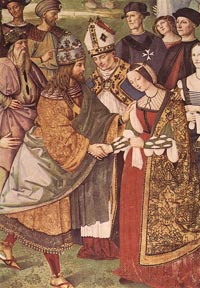
Aeneas Piccolomini Introduces Eleonora of Portugal to Frederick III (detail), fresco in the Piccolomini Library, Duomo, Siena.
Piccolomini presents the bride Eleanor of Portugal to Frederick III.

Pinturicchio, vault of the Piccolomini Library, Duomo, Siena
|
| |
|
|

|
Pinturicchio, Saint Bartholomew, ca. 1497, tempera on wood panel, Princeton University Art Museum
|
The apostle Bartholomew appears only briefly in the Bible, but his cult became popular. He was said to have traveled through Armenia and India, spreading Christ’s word, and to have been flayed alive. In this painting by the Perugia native Pinturicchio (literally, "clumsy little painter"), Bartholomew holds the instrument of his martyrdom. Calm in the face of fate, he trains a reverent gaze on a Bible or prayer book. His demeanor is exemplary, reminding the viewer that concentration and forbearance are required of the faithful. Attention to the image is encouraged through texture (the gold and silver relief of the halo and knife) and color (the background cloth of honor, decorated with interlocking gold crosses and foliate designs against a green background, turned slightly to reveal its complementary red reverse). Bartholomew’s book is of rich materials, with slender braided tassels and a stamped gold pattern on its cover — details of particular significance for this patron saint of leather workers [1].
|
|
|
|
| |
|
Spello
|
The old walled town lies on a regularly NW-SE sloping ridge that eventually meets the plain. From the top of the ridge, Spello commands a good view of the Umbrian plain towards Perugia.
The Church of Santa Maria Maggiore (known from 1159), probably built over an ancient temple dedicated to Juno and Vesta. The façade has a Romanesque portal and a 13th century bell tower, while the pilasters next to the apse have frescoes by Perugino (1512). The most striking feature is however the Cappella Bella frescoed by Pinturicchio. The Umbrian artist was called to paint it in 1500 by Troilo Baglioni, after he had just finished the Borgia Apartment's decoration. The cycle include the Annunciation, the Nativity and the Dispute with the Doctors, plus four Sibyls in the vault. The Palazzo dei Canonici, annexed to the church, houses the Town's Art Gallery.
|
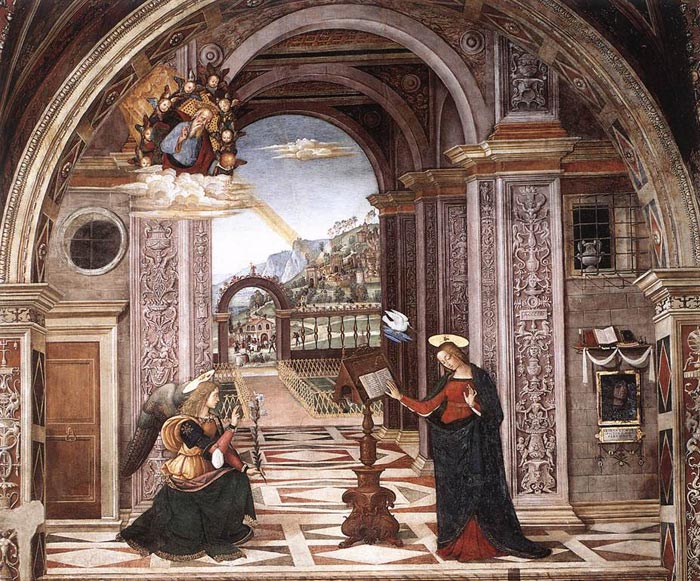 |
|
Annunciation, Cappella Baglioni, Collegiata di Santa Maria Maggiore, Spello
|
The Church of Santa Maria Maggiore is the location of an extraordinary cappella , decorated entirely with frescoes painted by Pintoricchio between the summer of 1500 and the spring of 1501.
In the Capella Bella the illustrations narrate the story of Maria. On the wall on the left is the l'Annunciazione, including wonderful episodes from daily life, further behind is the Adorazione dei pastori with the Cavalcata dei Magi further along. On the right, the Disputa di Gesù con i dottori. On the vaulted ceilings there are frescoes of Sibille Tiburtina, Eritrea, Europea, Samia. The rigorous planning of the designs, that was carried out using the latest rules of perspective from the XV century, did not inhibit Pintoricchio in expressing the finest detail and including anecdotes alongside the main images, extra stories that capture attention with the richness of their painting, their descriptive skill and the variation in the painted plants and flowers: all of which were executed using bright and precious colours. It is precisely due to this chromatic vivacity combined with the fresh narrative style, the rigour of the spatial design and the reflections from the tiled floor, that this place became universally known as the ‘Capella Bella’.
Members of the powerful and bloodthirsty Baglioni family, the rulers of Perugia, are painted as the Magi. An interesting parallel are the Benozzo Gozzoli frescoes in Florence which show the Medici family in the same role.
The Annunciation with its myriad of details and subplots, is an example of Pinturicchio's decorative style, so much admired in the nineteenth century. This scene betrays Pinturicchio's knowledge of ancient Roman painting, as well as his awareness of the value of still-life. With a touch of ingenuity, he includes on the right wall his own portrait, emblazoned with his name, as a painting within the painting.
The fresco Adoration of the Child decorates the eastern wall of the chapel. On two other walls of the chapel the Annunciation and the 12 years old Christ in the Temple are represented, while on the ceiling four sybils can be found.
|
|
|
| If you have been to see Perugino’s frescoes in the Collegio del Cambio in Perugia, you will be interested to see Pinturicchio’s self portrait. The artist included in the fresco his own portrait, emblazoned with his name, as a painting within the painting. Perugino had used the same trick in the Collegio del Cambio a year earlier. |
|
| |
|
|
|
 |
Duomo di Spoleto, Fresco: Pinturicchio - Chapel of the Bishop of Eroli
|
The Duomo (Cathedral) of S. Maria Assunta, in Spoleto contains the tomb of Filippo Lippi, who died in Spoleto in 1469, designed by his son Filippino Lippi. The church also houses a manuscript letter by Saint Francis of Assisi.
|
Rome
|
Pinturicchio's career skyrocketed in Rome where he was active on paintings such as this one for a local church, and where he was later hired by the reigning pope, Alexander VI.
The Bufalini Chapel frescoes in the Aracoeli require special mention because they are so characteristic of Pinturicchio and because they represent a high degree of accomplishment. He treats here a fairly new iconography, the life of St. Bernardine, who was coincidentally his name saint. The Death of St Bernardine has a spatial stage that opens out onto a deep, irregularly shaped piazza. The architecture throughout is thoroughly up-to-date and elegant, recalling Perugino's treatment in Christ Handing the Keys to St. Peter from the Sistine Chapel. The arrangement of the figures is uncontrived, almost accidental, with subscenes scattered throughout in the receding planes. Incidental naturalistic detail offers visual amusement, with the landscape in the distance treated with particular effectiveness. Pinturicchio had few peers among his contemporaries in integrating bright diversified vistas with his figures.
Pope Alexander VI (Cardinal Rodrigo Borgia was elected pope in 1492) entrusted the decoration of the rooms in his apartment (now known as the Borgia rooms) to Pinturicchio. The paintings, which were executed between 1492 and 1494, drew on a complex iconographical program that used themes from medieval encyclopedias, adding an eschatological layer of meaning and celebrating the supposedly divine origins of the Borgias. The rooms are: Room of the Sibyls, Room of the Creed, Room of the Liberal Arts, Room of the Saints, Room of the Faith.
These frescoes are problematic in degree of workshop participation. For the vast enterprise, presumably done rapidly, the painter had a number of collaborators, although the overall style, the taste, and the program must have been Pinturicchio's responsibility. The busily elaborated ceilings with motifs all'antica and numerous classical references, coupled with constant allusions to the Borgia, are definitely from Pinturicchio's hand.
Art in Tuscany | Frescoes in the Borgia Appartments of the Palazzi Pontifici in Vatican |
| |
|
|
|
 |
|
|
|
[1] Source: Saint Bartholomew (y1994-16) | www.artmuseum.princeton.edu
This article incorporates text from Wikipedia and from the Encyclopædia Britannica, Eleventh Edition, a publication now in the public domain, and WikiCommons Cathedral (Siena) - Piccolomini Library (71 F)
THE LIFE AND WORKS OF BERNARDINO DI BETTO, ALSO KNOWN AS PINTORICCHIO
Pintoricchio in Umbria | Itineraries and routes across today situated in their original locations: itineraries and routes across the whole territory guided visitors to the paintings in Perugia, Spello and other towns across Umbria (Spello, Church of S. Andrea, Pala con la Madonna col Bambino e Santi; Trevi, The San Francesco Museum Complex; Spoleto, Cathedral of Santa Maria Assunta; Orvieto, Cathedral of Santa Maria Assunta, and Città di Castello ,Museum of the Duomo). The Pintoricchio exhibition was planned to celebrate the 550th anniversary of the birth of Pintoricchio. | www.mostrapintoricchio.it
|
|
|
| |
|

Podere Santa Pia is a beautiful stone farmhouse only 2 km away from Castiglioncello Bandini. The main house is spacious, comfortable and well furnished and offers its guests a breathtaking view over the Maremma hills.
Podere Santa Pia is immersed in the utmost quietness where total privacy is guaranteed, in a scenic location 50 minutes away from the treasures of Siena. This idyllic rural retreat in one of the most characteristic areas of Tuscany, with wonderful views of the Maremma countryside, is the perfect place to relax and enjoy Tuscany's charms and atmosphere. The valley plain is a classic example of the Tuscan landscape, with endless hills, cypresses, wine, corn fields and streams. And this part of the Tuscany region offers the visitor such a feast of culinary delights it really is difficult to know where to start.
Holiday homes in the Tuscan Maremma | Podere Santa Pia
|
| |
|
|
|
|
|
|
|
|
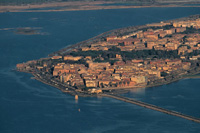 |
Podere Santa Pia |
|
Siena, Piazza del Campo
|
|
Orbetello |
| |
|
|
|
|
|
|
|
|
|
Siena, Piazza del Campo |
|
Lago Trasimeno |
|
Bagni San Filippo |
| |
|
|
|
|
|
|
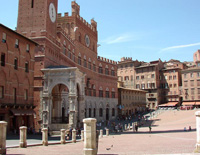
|
|
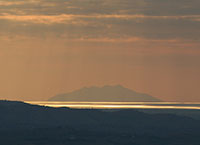
|
Siena, duomo |
|
Siena, Palazzo Publicco |
|
Sunsets in Tuscany
|
|
|
|
 |
Although this is off the beaten track it is the ideal choice for those seeking a peaceful, uncontaminated environment.
Podere Santa Pia, with its wide panoramic terrace overlooking the Maremma offers splendid views up to
the Tyrrhenian coast, Monte Christo and Corsica. |
|
Siena
The historical centre of Siena
At a centre of the social life in Siena is the Piazza del Campo, quite rightly held to be one of the most beautiful in Italy. With its mediaeval origins, it has the shape of a shell’s valve. It is ringed by a screen of antique buildings among which stands out the Palazzo Sansedoni (the 13th-14th century). Harmoniously inserted in the piazza is the Fonte Gaia, sculptured by Jacopo della Quercia between 1409 and 1419, buthere substituted by a copy. It was named “ Gaia” because it was inaugurated with great jubilation by the public.
In the background of the piazza is the Palazzo Publico built between 1297 and 1342. It is one of the most important works in Gothic style in Tuscany, with its central part higher than the rest. It was commissioned by the “Government of Nine”. The coat of arms of Siena is present above the windows. The façade in stone in its lower part andin the fired-brick in the upper, shows the symbol of Saint Bernard on the top floor and the emblem of the Medici in the middle of the first floor.
To the left of the public palace springs up the tower (102m) called la Torre del Mangia, built in 1348. The main part is made of fired-brick (88m) with the white coping. Below the tower is the chapel, la Cappella di Piazza, built between 1352 and 1376. It has a form of a loggia and was completed in Renaissance style in its upper part in the second half of 400. Nearby the entrance to the courtyard of the podesta, il Cortile del Podestà, which is on the right side of the chapel, one can get a breathtaking glimpse of the tower, which can be climbed from here by a stairway of 503 steps to the top of the tower.
From the courtyard you can enter the civic museum (il Museo Civico) and proceed into the Hall of the Risorgimento with its frescoes of the late 1800 narrating Facts in the life of Vittorio Emanuele. Then follows the Hall of the Priors with the frescoes illustrating the life of the Sienese Pope Alessandro III by Spinello. In the vault are the Allegories of virtue by Martino di Bartolomeo. Moving on through the Hall of the Cardinals and into the Consistory, you reach the Antechapel with its frescoes by Taddeo di Bartolo, and the Chapel. Then one enters the Sala del Mappamondo where you can admire the Maestà, a masterpiece by Simone Martini who started this work in 1312. On the opposite wall is another very important work by Simone Martini – Guidoriccio da Fogliano that dates from 1328. Under this work, Sodoma, in 1529 painted San Vittore and Sant’Ansano, two saint protectors of Siena. On the upper part of the wall, in front of the window are the works by Lippo Vanni (The battle of the Val di Chiana ) and by Giovanni di Cristofano Ghini and Francesco d’Andrea (The battle of the Poggio Imperiale); bellow are some of the most important Sienese Saints: Beato Bernardo Tolomeo by Sodoma, San Bernardino by Sano di Pietro and Santa Caterina by Vecchietta. On the right you can access the Hall of Peace, which was the seat of the Government of Nine (1292 to 1355). Here are the celebrated allegoric frescoes by Ambrogio Lorenzetti : ”Allegory of the Good Governing”( 1338/40) and “The effects of good governing in the town and in the countryside”, which shows the positive effects of the Government of Nine. On the opposite wall is the “Misgovernment and its effects “. In front of the elegant 15th century Palazzo dell’Università you find Palazzo Piccolomini built, it is thought, by Rossellino in 1469. From 1855 it is a seat of the State Archive, and here are kept the most important historical documents, which are on display. Very interesting is the collection of Tavolette di biccherna: the covers of the public registers painted on small scale by the Sienese artists. The authors of these works, commissioned between 1258 and 1682, are Domenico Beccafumi, Francesco di Giorgio Martini, Ambrogio and Pietro Lorenzetti. In one of the most busy parts of the town, which is called Croce del Travaglio, rises the Loggia della Mercanzia in Gothic Renaissance style with the façade in the form of arches on pillars with niches containing the statues of Saints by Federighi and Vecchietta. From here depart the three main arteries of the town: Via di Città, the Banchi di Sotto and the Banchi di Sopra. The Cathedral – il Duomo- although the most important monument of the citizens, it is one of the most beautiful creations of the Italian Gothic. The Cathedral was begun in 1229 but it was finished only at the end of the next century. A great boost was given to the work from 1258 to 1285 by the monks of St. Galgano abbey who called in Nicola and Giovanni Pisano.
The façade, in Romanesque- Gothic style, was finished between 1376 and 1382 and is animated by the numerous statues sculptured by Giovanni Pisano, today substituted by copies. The upper part of the façade, inspired by the flamboyant Gothic, is by the Sienese Giovanni di Cecco.
The inside is Romanesque with interesting frame of the busts above (15th and 16th century). These are the imaginary busts of 171 Popes. The main floor of the Cathedral is subdivided into 56 squares, partially in graffito, partly in marble mosaic, which narrate the facts from the Old Testament. The holy water stoups, placed in the middle nave, are by Federighi. It is worth noting the Piccolomini altar with the statues in the niches by a young Michelangelo and also the Piccolomini Library built in 1492 on the wish of Cardinal Francesco Todeschini Piccolomini. The walls are decorated with the frescoes by Pinturicchio.
Into the transept are open the Chapel of the Madonna of the Vow and the Chapel of S.Giovanni Battista, the presbytery with beside the famous Pergamo by Pisano and the Sacristy, which is rich mainly in the frescoes of fifteenth century Sienese masters. Bellow the apse of the Cathedral is the Baptistery, which was built between 1316 and 1325, with the façade in the Gothic style. Inside are the frescoes by various authors and The Baptismal Font designed by Jacopo della Quercia, a masterpiece of Tuscan Gothic sculpture of the Renaissance.
Art in Tuscany | Siena | The Duomo
Art in Tuscany | Pinturicchio, Frescoes in the Piccolomini Library of the Duomo in Siena
|
|
|
| |
|
|
|
| |
|
|
|
| |
|
|
|
| |
|
|
|
| |
|
|
|
| |
|
|
|

